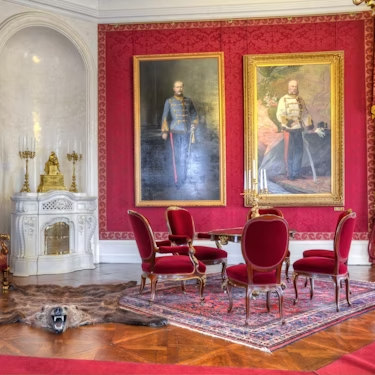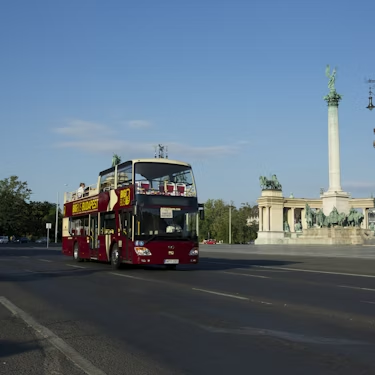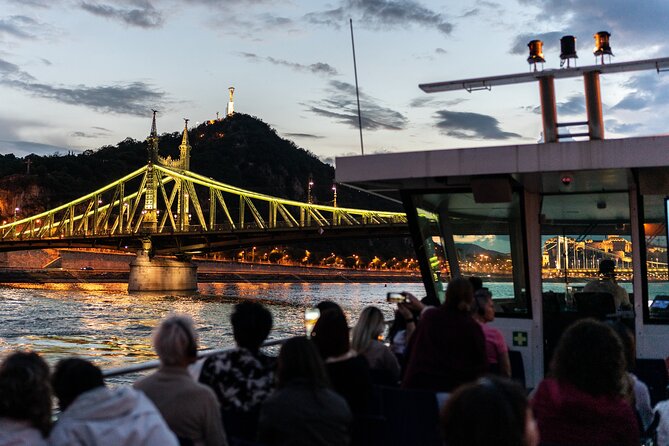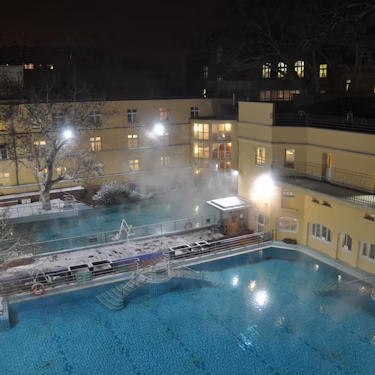More about: Temple and Synagogue Tickets and Tours in Budapest
If you plan to visit Budapest, you'll find that it's a city that stands out for its architectural richness. The castles, palaces, suspension bridges and medieval cobbled streets contribute to create a fairytale skyline, but the churches and synagogues also do their part, which not only offer beauty, but also a sample of the religious tolerance that historically distinguished the Hungarian capital.
Visiting the Great Synagogue, touring St. Stephen's Basilica, seeing St. Matthias Church and being amazed by the Gellert Hill Cave Church are some of the best things to do in Budapest, a multicultural and vibrant city that will take your breath away.
1. Great Synagogue of Budapest
The Great Synagogue of Budapest, also known as the Dohany Street Synagogue, is the largest synagogue in Europe and one of the largest in the world. During the Second World War, this temple became a temporary refuge for Jews persecuted by the Nazis, as well as a place where the belongings of the deportees were stored. This is why today it is not only a religious monument, but also a memorial to the Holocaust.
The synagogue is also a symbol of Hungary's rich Jewish history, and in the immediate vicinity is the Jewish Museum, which houses objects that tell the story of Jewish life in Hungary before and after the war, as well as being the site where Theodor Herzl, the founder of modern Zionism, lived for much of his life.
The church's architecture combines Moorish, Byzantine and Gothic styles with oriental decorative details. Its façade is adorned with red and yellow bricks and two octagonal towers crowned with onion-shaped domes. The interior is rich in detail, with hanging chandeliers and horseshoe arches. A visit to the Great Synagogue is a must for both its historical value and its architecture.
Interesting details
- Price: General admission costs approximately 7 euros.
- Location: Dohány u. 2, Budapest.
- Opening hours: Sundays to Fridays from 10.00 am to 8.00 pm.
2. St. Stephen's Basilica
If you want to get to know one of the most beautiful buildings in Budapest and one of the protagonists of the itineraries of the best guided tours of the city, you cannot miss a visit to St. Stephen's Basilica. This Catholic church is one of the most important in Hungary and an essential landmark in the capital. The basilica is also named after the country's first king, who is considered the founder of the Hungarian state.
One of the most remarkable aspects of St. Stephen's Basilica is the relic it houses: the mummified right hand of King St. Stephen, known as the Holy Right Hand. This relic, revered by many, attracts both worshippers and tourists from all over the world, giving the basilica both a spiritual and historical character. In addition, it has a capacity of more than 8,000 people, making it one of the largest churches in Hungary.
Architecturally, the basilica is a mixture of neoclassical and Renaissance styles, with a façade adorned with Corinthian columns and a dome that dominates the Budapest skyline. If you wish, during your visit you can climb to the top of the church, from where you can enjoy a sweeping panoramic view of the city.
On the other hand, the strategic position of St. Stephen's will allow you to visit other main attractions of this destination, such as the Andrassy Avenue or the Parliament of Budapest, for which you can get tickets here.
Interesting details
- Price: from 17 euros.
- Location: Szent István tér 1, Budapest.
- Opening hours: Monday to Saturday from 9.00 am to 5.45 pm.
3. Matthias Church
Located at the top of Buda Castle Hill, Matthias Church is one of the most iconic churches in Budapest. Its history dates back to the 13th century and over the centuries it has witnessed some of the most important events in Hungarian history, such as royal coronations and religious ceremonies of great significance. In addition, during the Ottoman occupation, the church was converted into a mosque, thus showing a crossover of styles.
The church is famous for being linked to King Matthias Corvinus, one of Hungary's most important monarchs, who ruled in the 15th century. It was during his reign that the church was renovated and embellished, and it is to him that much of its late Gothic splendour is attributed. Matthias also celebrated two of his weddings in this church, cementing his historical link with the building.
The architecture of Matthias Church is a fusion of Gothic and neo-Gothic styles, notable for its towers, stained-glass windows and diamond-shaped tiled roof. The interior is no less impressive and is decorated with frescoes, colourful details and a statue of the Virgin Mary on the high altar.
Nearby you can visit Buda Castle, the Fisherman's Bastion and see some of the best sweeping views of the Hungarian capital from above. It is also one of the attractions listed on the Budapest Card tourist pass.
Interesting details
- Price: from 5 euros.
- Location: Szentháromság tér 2, Budapest.
- Opening hours: daily from 9.00 am to 5.00 pm.
4. St. Anne's Church in Pest
St. Anne's Church in Pest is one of the most outstanding Baroque buildings in the city. Built by the Jesuits, this church has withstood invasions, wars and political changes, but has always maintained its importance as a place of worship and as a historical landmark, as during the Turkish occupation the area was devastated. However, the reconstruction of the church marked a spiritual and cultural renaissance in the region.
The exterior of this church, unlike other Jesuit temples, is majestic and features twin towers topped with domes, creating a symmetrical balance. Stone carvings and statues of saints, including St. Ignatius of Loyola, founder of the Jesuits, adorn the façade and give importance to the central nave.
On the other hand, its location adjacent to the Danube River makes it an easily accessible attraction for visitors touring Budapest's historic centre. In fact, the Hungarian Parliament, the Chain Bridge and the Váci Utca shopping district are just a few minutes away.
Interesting details
- Price: admission is free.
- Location: Szervita tér 6, Budapest.
- Opening hours: daily from 9.00 a.m. to 6.00 p.m.
5. Szilagyi Dezso Square Reformist Church
If you want to see one of Budapest's best-kept secrets, don't miss the Reformist Church in Szilagyi Dezso Square. Built in a neo-Gothic style with influences from local Hungarian architecture, its construction coincided with a period of great development for the reformist community in Hungary, which sought to reflect its identity through distinctive architecture .
The church, however, is notable for its sobriety and simplicity, typical of the reformist style, which rejects excessive decoration in favour of a more austere, spiritually focused atmosphere. Its façade is of red brick with geometric detailing, and its octagonal bell tower, crowned by a pointed spire, has become a distinctive symbol of the Buda landscape. The equally simple interior has a wide nave and a carved wooden ceiling.
In terms of importance, this church has been a symbol of the Protestant community in Budapest since its inauguration. During the years of the World Wars the church was damaged, but was successfully restored, standing as a reminder of the resilience and strength of the Reformed community.
Interesting details
- Price: admission is free.
- Location: Szilágyi Dezső tér 3, Budapest.
- Opening hours: Monday to Friday from 10.00 a.m. to 5.00 p.m.
6. The Parish Church of St. Elizabeth of Arpad House
The Parish Church of St. Elizabeth of Arpad House is not one of the main churches in Budapest, but it is of great historical and architectural importance in the city. Built in honour of St. Elizabeth of Hungary, a Hungarian princess canonised for her dedication to the poor and the sick, the church was built during a period of great nationalist fervour, when it sought to honour key figures in local history, Elizabeth being one of the most beloved for her legacy of charity and Christian devotion.
With its unmistakable neo-Gothic architecture, designed by the architect Imre Steindl, the same creator of the Hungarian Parliament, the church is 76 metres high and is inspired by the great medieval European cathedrals. The front is adorned with ornate details, including pointed arches, gargoyles and stained glass windows depicting scenes from the life of St. Elizabeth.
The church also hosts classical music concerts and religious events of significance to the local community, especially at Christmas time . If you plan to visit Budapest in December, you can attend the festive eve celebrations here.
Interesting details
- Price: from 5 euros.
- Location: Rózsák tere 8, Budapest.
- Opening hours: daily from 7.00 am to 12.00 noon and from 3.00 pm to 7.00 pm.
7. Kazinczy Synagogue
The Kazinczy Synagogue is one of the most important Hebrew temples in the city, but mainly an example of Hungarian Art Nouveau architecture. Designed by the Loffler brothers, famous architects of the early 20th century, it remains a symbol of Budapest's Jewish community and, unlike other better-known synagogues in the Hungarian capital, it represents the Orthodox tradition and its design is aligned with the strict rules of this branch of Judaism.
The history of the Kazinczy Synagogue is also deeply connected to the ups and downs of Budapest's Jewish community. During World War II, the Jewish quarter was turned into a ghetto and many of the religious buildings, including the synagogue, were damaged. However, in the decades after the war, the Kazinczy Synagogue was restored and is now a landmark of resistance and the continuity of Jewish life.
Nearby you can enjoy the surrounding area and take part in some of the best tours of Budapest's Jewish Quarter.
Interesting details
- Price: admission is free.
- Location: Kazinczy u. 29-31, Budapest.
- Opening hours: daily from 10.00 a.m. to 3.00 p.m.
8. Gellert Hill Cave Church
If you are one of those who enjoy discovering the most unique sites of each destination when visiting a city, then you cannot miss the Gellert Hill Cave Church, which is hidden in the heart of a cave carved into the rock.
Its history dates back to 1926, when it was established by Pauline monks who found the cave an ideal place for spiritual retreat and prayer. Inspired by the holy cave of Lourdes in France, the monks decided to turn this natural space into a place of worship dedicated to the Virgin Mary. However, the communist regime sealed the entrance to the church and persecuted the monks. It was not until the fall of communism in 1989 that the church was reopened and restored, regaining its religious and spiritual function.
The most remarkable feature of the Cave Church is its architecture, as it is carved directly into the rock of Gellert Hill, giving it a mystical and austere atmosphere. Instead of following the model of traditional churches with large facades and towers, its entrance is discreet, camouflaged by the natural rock. The interior is also made of natural limestone and features a series of altars and statues.
The location of the Cave Church is another attraction, as it is situated on the iconic Gellért Hill, which offers some of the best panoramic views of Budapest.
Interesting details
- Price: admission is free.
- Location: Szent Gellért rkp. 1, Budapest.
- Opening hours: Monday to Saturday 9.30am - 7.30pm.
9. Ruined Church of St. Mary Magdalene
The Ruined Church of St. Mary Magdalene is one of the most striking monuments in the city. Built by the Franciscans in the 13th century, the church originally served as the main place of worship for Hungarian Christians in Buda, while the nearby Matthias Church was intended for worshippers of other nationalities. However, it was razed to the ground during the Ottoman occupation and converted into a mosque.
The architecture of the church, or what remains of it, combines Gothic and Romanesque elements, reflecting the different phases of its construction and influences over the centuries. Although much of the structure was destroyed during the bombings of World War II, the Gothic bell tower and some walls have survived, standing as a reminder of Budapest's medieval Catholic history.
During the communist era, the ruins were abandoned, but in the late 20th century their historical significance has been enhanced. Today, the site is not only a place of reflection on the past, but also a cultural space where concerts and open-air events are held. It is also a magical place to wander around during snowy days, a pleasure to enjoy if you plan to visit Budapest during the winter.
Interesting details
- Price: admission is free.
- Location: Kapisztrán tér 6, Budapest.
- Opening hours: daily from 10.00 to 18.00.
10. St. Michael's Church in Budapest
St. Michael's Church is one of the oldest Catholic churches in the city. Built on the remains of a medieval church destroyed during the Ottoman occupation, this late Baroque church survived the bombings of World War II, even serving as a shelter for the local community.
The church's main altarpiece, which is dedicated to St Michael the Archangel and is the main attraction of this site, is a masterpiece depicting the archangel in his fight against evil. The side altars accompany the setting with sculptures and details that reflect the devotion and Hungarian grandeur of the time in which it was built.
On the other hand, in the vicinity of St. Michael's Church you can enjoy one of the most dynamic areas of the city: Váci Street. This is Budapest's main pedestrian and shopping artery, where you can explore the trendy shops, cafés and restaurants that are often included in the best gastronomic tours of the Hungarian capital
Interesting details
- Price: admission is free.
- Location: Váci u 47/b, Budapest.
- Opening hours: daily from 13.00 to 18.00.













